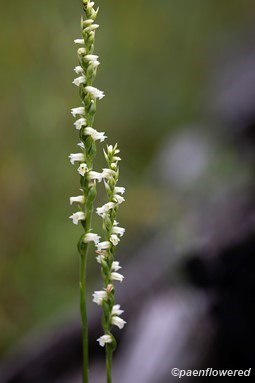Spiranthes casei
Spiranthes casei case's ladies’-tresses
Spiranthes casei was first described by Paul Catling and James Cruise in the mid-1970s. Its small cream-colored flowers appear almost truncated in comparison to S. cernua and other members of its "complex" – the lips, which are yellow inside, are shorter and the overall flower structure is narrower. S. casei also stands out because of its somewhat earlier flowering time, usually peaking in our area in mid-August, while most other members of the S. cernua complex bloom from September to October.
S. casei typically grows to around 10-12 inches tall. Like most other members of the its genus, its narrow to oval-shaped lower leaves usually wither and disappear by the time it blooms. It is found in dry, rocky habitats – in our area, it often prefers areas along railroad tracks and old railroad beds.
This species has a very limited range, from the Great Lakes eastnortheast to the maritime provinces of Canada. A disjunct population is found in Pennsylvania in McKean, Potter, Tioga, and Lycoming counties, almost exclusively along railroad rights-of-way. The prevailing theory, put forward by Paul Martin Brown, is that seeds were inadvertently transported to the state from New England in white cedar railroad ties, out of which the plants can often be found growing.
Sources:
Catlin, Paul M. and James E. Cruise. 1974. Spiranthes casei, A New Species from Northeast North America. Rhodora, 76(808): 526-536.
Brown, Paul Martin. 2008. The Taxonomy and Distribution of Spiranthes casei in Northern New England. North American Native Orchid Journal, 14(3).
Habitat & Range
Very rare in dry, open sandy soils.
Present in the northcentral part of the state.
Wetland code: Not classified
Phenology
Flowers August to September.
Plant Codes
PA status: PE (Endangered)
S-rank: S1 (Critically imperiled)
G-rank: G4 (Apparently secure)













Comments
Have you spotted this plant in your area? We'd love to hear about your experience! Share your comments or questions about the plant below. Comments are moderated before posting.